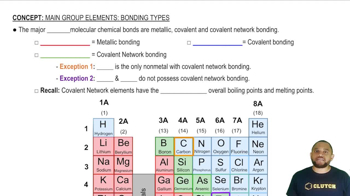Textbook Question
Write Lewis structures for each molecule or ion. Use expanded octets as necessary. a. PF5
539
views

 Verified step by step guidance
Verified step by step guidance



Write Lewis structures for each molecule or ion. Use expanded octets as necessary. a. PF5
Write Lewis structures for each molecule or ion. Use expanded octets as necessary. b. AsF6-
Order these compounds in order of decreasing carbon–carbon bond length: HCCH, H2CCH2, H3CCH3.
Which of the two compounds, H2NNH2 and HNNH, has the strongest nitrogen-nitrogen bond, and which has the shorter nitrogen-nitrogen bond.
Hydrogenation reactions are used to add hydrogen across double bonds in hydrocarbons and other organic compounds. Use average bond energies to calculate ΔHrxn for the hydrogenation reaction. H2C=CH2(g) + H2(g) → H3C–CH3(g)